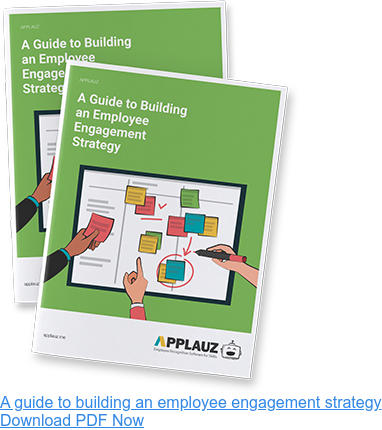You've probably experienced being "on the fence" about a place of work.
Eventually, you made a final decision — you either left or stayed at the job. After all, you can only live in limbo for so long.
During the "in-between" stage, you probably acted a little differently at work. Maybe it wasn't obvious; but it was subtle enough for some people — especially those who work closest to you — to notice.
It's not black & white
Employee engagement is dynamic. It exists in shades of grey. Simply put, engagement ebbs and flows in the same employee throughout their tenure.
On the one hand, this truth makes spotting disengagement a challenge; it requires businesses to keep their finger on the pulse of employee happiness and satisfaction.
But great managers view this truth as an advantage because it means troubled employees can be identified early, before full disengagement sets in.
The Many Faces of Employee Disengagement

If you search online for "signs of employee disengagement," you will find very long lists of singular behaviours.
These signs range from "frequently distracted" to " displays lazy attitudes."
While this can be true, these lists suggest nothing about the degree of unhappiness the employee is experiencing. In other words, how close are they to quitting?
With this particular framework, however, behaviours are tied to a distinct stage leading up to turnover. As a result, managers can better judge the severity of the issue at hand.
The 3 Stages of Employee Disengagement
Few managers feel blindsided by an employee's departure. In other words, they almost always saw it coming.
If managers make time to connect with their employees and check in regularly, it becomes quite clear when something is "off. Realistically, it's difficult for people to hide their feelings of unhappiness for too long.
When an employee is unhappy at work, their behaviour and actions will follow a predictable trajectory. If any of this behaviour sets off an internal alarm for managers, it’s important to have that conversation — even if it will be difficult — as it will ensure the underlying issues are brought to the surface and not left to fester.
1. They speak up
An employee communicating a general frustration is often the very first "sign" disengagement is coming.
Unless your culture discourages open communication, most professionals will speak up when they encounter issues at work, whether it's passive or active.
The problem is managers don’t always catch on. Why? Because in a professional environment, people rarely express frustrations in a forceful manner — particularly agreeable workers or new staff.
On the contrary, frustrations are usually expressed as constructive feedback, comments, or suggestions. In consequence, managers often minimize the importance of the comment or overlook it entirely.
Bottom line: every piece of employee feedback is important, regardless of how it's delivered.
Be attentive to what your employees are telling you. The earlier management intervenes, the better. It's not the issue itself (ex. low pay) that causes an employee to disengage fully; it's management's lack of action that prompts workers to detach.
So, make sure to take action before the problem spills over and taints their attitude. Or worse, harmed their productivity.
2. Emotional absence and detachment
An employee's attitude takes a hit in the face of repeatedly having their opinions and feedback overlooked. They feel unheard. Feelings of apathy begin to set in.
At this stage, the employee feels disempowered. As a result, they begin to check out.
In short, when a negative mindset starts to taint an employee's attitude, they will detach themselves emotionally from work.
At this stage, it's common for employees to be searching for or considering other jobs. At the very least, they are daydreaming about themselves in "greener pastures."
Symptoms to look for: absenteeism, distracted work, seldom meeting deadlines, rarely asking questions or offering input, and avoiding social events.
In short, an important sign of a detached employee is withdrawal.
That said, more precise methods exist to measure how engaged an employee is at work, such as with Pulse Surveys. Be mindful, however, even though these surveys are anonymous, employees may not be candid when filling them out.
That's why a great manager should combine the power of data and intuition to make a proper diagnosis. When it comes to managing humans — with complex needs and nuanced emotions — your gut is often the best barometer.
In short, when something feels "off," your instincts should ring an internal alarm. Good managers should be in tune with their internal alarm and know when it's time to step in.
3. Decreased effort and productivity
Behaviour and emotions go hand in hand.
A lack of emotional attachment to work will spill over and impact productivity. A checked-out employee can only hold up a false front for so long.
Look for an employee who puts in less effort or does the minimum required to keep their job. For example, if they are not meeting deadlines or delivering poor-quality work with obvious mistakes.
Is this an otherwise intelligent and capable employee? If so, you should take these signs seriously and intervene, as turnover is likely imminent.
When productivity is so low, it raises a red flag; the employee is likely searching for work elsewhere. It's possible they accepted an offer and are waiting to announce it to their current manager.
One final (counter-intuitive) remark: you may see an uptick in productivity in the final stage of employee disengagement. A restored sense of optimism and control can positively impact their productivity.
Preventing Employee Turnover by Responding to Disengagement

When identifying disengaged employees at any point on the spectrum of disengagement, managers should ask themselves some questions before jumping to solutions.
Here are some key questions managers should ask when they spot disengagement and suggestions on what to do next.
1. Is there an external issue?
The most important thing to consider is if the employee’s attitude and behaviour are impacted by something outside of the organization’s control.
For example, are they going through a divorce, experiencing mental health issues, do they have a young child or a family member to care for that is draining their energy, have they been ill recently, and so on. Make sure to speak to your employees about these aspects of their life.
Offer support while they are going through a difficult time.
Suggestions for next steps: You’ve identified the external factors impacting the employee’s low morale. Now, it’s time to have an open conversation about what they can realistically deliver during this time. Simply put, you need to talk about the impact on their performance. Keeping your expectations clear so neither party gets frustrated or let down is vital.
2. Evaluate the workload
Disengagement often stems from the sheer volume and complexity of the workload you are giving your employees. Consider some of the following questions:
- Are the goals/quotas realistic?
- Are the goals/quotas too low?
- Is the work too complex and difficult, do they need more resources
or support? - On the other hand, is the work not challenging enough?
Although it may seem counter-intuitive, disengagement often grows out of employees feeling bored and not sufficiently challenged! Many people go to work wishing to learn and grow.
Suggestions for the next steps: If one employee is having trouble with the workload — whether it’s too much or too little — chances are many of your team members are feeling it too. Take this time to focus on auditing the workload. Understanding if your employees are feeling overworked or not. Sometimes a given quota can be feasible for 6-months but can be detrimental and draining in the long term.
3. Does the employee match the job
During this step, you must be honest with yourself and your employees. Ask yourself, is this employee a good fit for this role? Are they overqualified and bored? Are theyunderqualifiedand struggling? Also, ask yourself if they are a good fit for the culture of the department and company.
When employees struggle in their role, it's easy to conclude that it must be a problem with them. But everyone can be excellent at something. If they are not thriving, they are likely in the wrong job, or there is a mismatch between their tasks and skills.
Suggestions for the next steps: There are ways to offer an employee new opportunities for growth and challenge without a promotion. You must first get to the root of their frustration and explore their professional goals. For example, ask yourself: Where are they struggling? Do they want more autonomy, challenge, or expertise? When employees are restless for change, they are actually looking for the benefits that come with a new position, not just a new title.
4. Does this employee feel included and heard
Employee disengagement is often the result of an employee feeling powerless about a work issue, not the issue itself.
Lack of control over one's environment results in anxiety and stress among employees. Research shows lack of control is a key driver of employee burnout. In the end, this feeling of powerlessness becomes more solidified when a manager doesn't take action.
Suggestions for the next steps: The best thing a manager can do here is to take time to connect with employees and hear them out. Listen closely to any frustration they may have. And most importantly, take action where they can. If a resolution requires more time and resources, at the very least, demonstrate to employees you're working on fixing the issue and addressing their complaints. Always try and keep the lines of communication open and transparent.
5. Does the employee feel recognized and appreciated for their work
A crucial part of happiness at work is feeling appreciated and recognized. Praise is a potent motivator. If an employee is disengaged, you should ask yourself, "how often am I taking the time to recognize this employee's hard work sincerely and honestly."
Remember: Only giving surface-level "good jobs" is not enough for an employee to feel truly appreciated. Impactful recognition is specific. It highlights the employees' contributions and efforts. When you don't acknowledge employees in this way, they'll disengage.
Suggestions for the next step: There are countless reasons to give recognition at work. Great managers praise employees who deliver outstanding results and work hard. You can set up a formal recognition program and software. Or make an effort to give more recognition in a group meeting, email, or chat channel. Giving meaningful recognition is a low-cost way to address disengagement in both the short and long term.
Final Thoughts

Most companies falsely believe fancy programs and policies will fix their disengagement issues. But throwing money at the problem or only relying on HR programs ignores an important reality.
People must solve people problems. In other words, engaging employees requires one crucial ingredient — it's caring. This care begins with a strong manager-employee relationship.
You can keep employee disengagement at bay by addressing the root of employee unhappiness. The first step is to have frequent, open conversations. Even if you can't resolve every one of the employee issues right away (that is not realistic!), they at least feel heard and appreciated.




